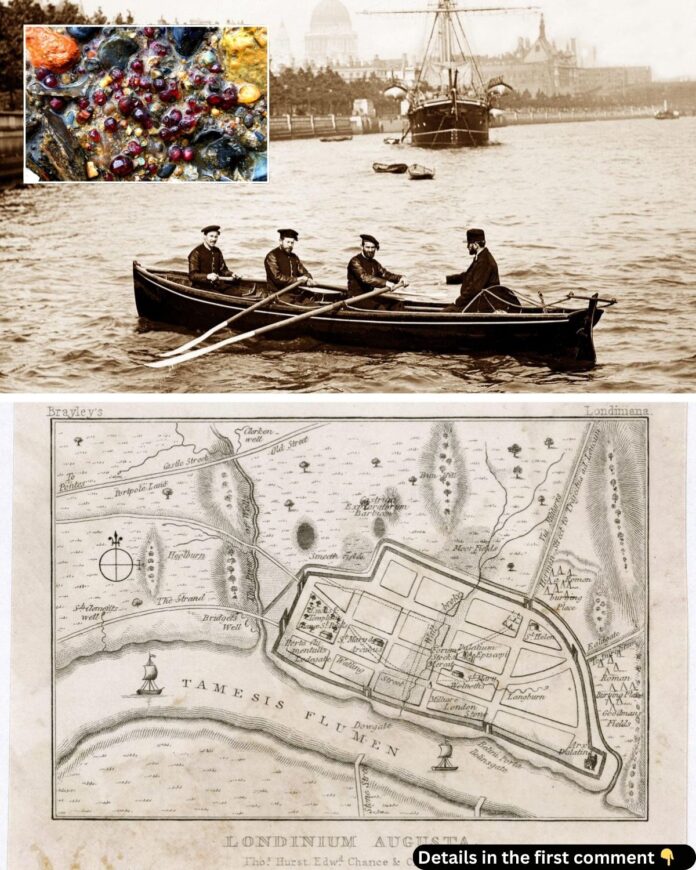The River Thames, winding through the heart of London, has long served as a gateway to history. Its banks and foreshore are treasure troves of artifacts, from Roman coins to Victorian buttons. Among these finds are the enigmatic Thames garnets—tiny, deep red stones that sparkle like pomegranate seeds against the mud. Their beauty is undeniable, but their presence raises an intriguing question: how did these non-native gemstones end up in the river, and what secrets do they hold?
The Beauty and Rarity of Thames Garnets
The Thames garnets are striking in their appearance, ranging from jagged raw stones to meticulously faceted gems. Their purplish-red hues stand out vividly against the muted tones of the riverbank. While Britain is home to other gemstones, such as Whitby jet and agate, garnets are not among them. The Scottish Highlands produce garnets, but those are too flawed for use as gemstones, making the presence of these polished and faceted garnets along the Thames an enduring mystery.

Adding to their allure, Thames garnets are not scattered randomly along the foreshore. They tend to appear in specific spots, the locations of which are closely guarded by mudlarks—licensed individuals who scour the riverbanks for lost treasures. Their rarity and concentrated presence deepen the intrigue surrounding these gems.
Join the search for gems in the Thames – watch the video to uncover the mystery of the garnets found while mudlarking and the fascinating history behind this discovery!
Theories Behind the Origins of Thames Garnets
The origins of Thames garnets are shrouded in speculation. Scholars and enthusiasts have proposed several theories to explain their appearance in the river, each offering a fascinating glimpse into London’s history.

Industrial Byproducts Theory
One theory suggests that the garnets are remnants of industrial production. Garnet-based sandpaper, known for its abrasiveness, was used in London’s furniture-making industry. However, this explanation falls short when considering the faceted nature of many Thames garnets, which appear more suited for jewelry than industrial use.
Shipwreck Hypothesis
Throughout its history, the Thames has served as a major trade route, connecting London to the rest of the world. It is possible that one of the many trading vessels navigating the river capsized, spilling a cargo of garnets into the water. Over centuries, these stones could have washed ashore, creating the treasure troves found today.
Smuggling and Contraband Connections
During the 17th to 19th centuries, smuggling was rampant in Britain. Garnets, considered valuable luxury items, were subject to heavy import duties. Some theorize that sailors smuggling garnets into London may have deliberately dropped them overboard to retrieve later at low tide, only for them to be lost to the river forever.
Ancient Trade Routes and Anglo-Saxon Connection
Archaeological evidence suggests that garnets were highly prized by Anglo-Saxons, often used to adorn intricate metalwork found in burial sites. Professor Helena Hamerow of Oxford University identified a significant concentration of garnet-encrusted artifacts in the Thames Valley dating back to the sixth century. This indicates that garnets were transported to London via ancient trade routes, making it plausible that some were lost to the river during transit.
The Art of Mudlarking: Discovering Thames Garnets

Mudlarking, the practice of searching riverbanks for historical artifacts, has gained renewed interest in recent years. While anyone can stroll along the Thames, only licensed mudlarks are legally permitted to remove items from the riverbanks. The process requires patience, a sharp eye, and a deep respect for the history beneath the mud.
For mudlarks, Thames garnets are prized finds. Heather Stevens, a dedicated mudlark, recalls her first discovery of the tiny red stones. Initially mistaking them for shards of glass, she later learned of their historical significance. Now, she collects them regularly, marveling at their beauty and mystery.
Thames garnets tend to appear in specific, secret locations along the riverbank. These spots are closely guarded within the mudlark community, adding an air of exclusivity to their discovery. For those lucky enough to find one, the garnets serve as tangible links to London’s past.
The Thames Police and the Fight Against Smuggling

The history of the Thames is intertwined with stories of smuggling and crime. In 1798, the Thames Police was established to combat widespread smuggling, which was costing traders vast sums in lost revenue. Garnets, often imported from far-off regions, were among the goods targeted by smugglers.
The high value of garnets and the hefty import duties imposed on them made them ideal contraband. Some historians speculate that sailors working on cargo ships deliberately tossed sacks of garnets into the river to evade taxes, intending to retrieve them later. However, these plans may have been thwarted by the tide, leaving the gems buried in the riverbed for future mudlarks to discover.
The Ongoing Mystery of the Garnets
Despite the many theories, the origins of Thames garnets remain elusive. Dating these stones is particularly challenging. Unlike metal artifacts or pottery, garnets lack the contextual clues needed for precise dating. This has left historians and archaeologists with only educated guesses about their journey to the Thames.
What is clear, however, is their historical and cultural significance. The garnets symbolize London’s rich history as a hub of trade, industry, and intrigue. They connect modern-day mudlarks and enthusiasts to centuries of human activity along the river, offering a glimpse into the lives of those who lived, worked, and traded in the city.
Conclusion
The Thames garnets are more than just beautiful stones; they are fragments of history, washed up on the shores of one of the world’s most iconic rivers. Their mysterious origins invite speculation and wonder, bridging the gap between past and present.
For mudlarks and historians alike, these tiny gems serve as reminders of London’s enduring connection to the wider world, its bustling trade routes, and its hidden stories waiting to be uncovered. As they glimmer against the muddy foreshore, the Thames garnets continue to capture the imagination of all who seek them, preserving the allure of the unknown in the heart of a modern metropolis.
